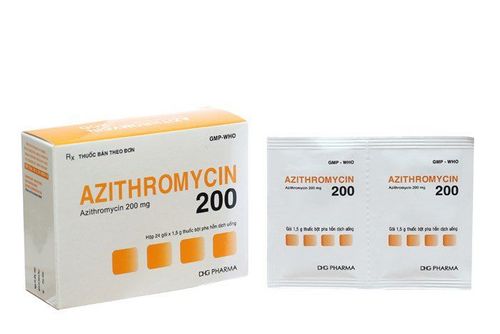This is an automatically translated article.
Bronchodilators help people with asthma relax the muscles around the airways and clear mucus from the lungs. The drug is available in a variety of forms, including inhalers, nebulizers, and tablets. Although asthma cannot be cured, it can be controlled. These anticholinergics are bronchodilators useful in chronic obstructive pulmonary disease.
1. What is a bronchodilator?
A bronchodilator is a medicine that makes breathing easier by relaxing the muscles in the lungs and widening the airways.
They are often used to treat long-term conditions where the airways can become narrow and inflamed, such as:
Asthma, a common lung condition caused by inflammation of the airways. Chronic obstructive pulmonary disease (COPD), a group of lung diseases, often caused by smoking, makes breathing difficult.
2. The effect of bronchodilators
Bronchodilators can be:
Short-acting: used for short-term relief from sudden, unexpected episodes of shortness of breath. Long-acting: used regularly to help control shortness of breath in asthma and COPD, while increasing the effectiveness of corticosteroids in asthma.
3. Anticholinergic bronchodilators
3.1. Atropine Administration of atropine systemically or as a nebulized solution, leads to bronchiectasis. Inhaled doses of 2.5 mg atropine have been associated with side effects such as dry mouth, tachycardia, palpitations, and blurred vision. At higher inhaled doses, systemic absorption may lead to urinary retention (especially in the elderly), headache, and altered mental status. Therefore, Atropine is no longer used as a nebulizer solution.
3.2. Ipratropium bromide Ipratropium bromide is a structural analogue of atropin, with a quaternary nitrogen structure. This structure reduces the ability of the molecule to cross the cell membrane. Therefore, systemic absorption with aerosol ipratropium is less than with atropine aerosol. Ipratropium blocks methacholine-induced bronchoconstriction and induces bronchodilation in asthmatics and chronic obstructive pulmonary disease (COPD) patients. There was no measurable effect on sputum volume, sputum viscosity or mucosal clearance with the clinically recommended dose of ipratropium.
Maximum bronchodilator with ipratropium, inhaled from a dosing inhaler, occurs at a dose of 40-80 micrograms. Although some bronchiectasis is apparent soon after inspiration, the maximal response occurs 1.5-2.0 hours later. The duration of significant bronchiectasis following a standard dose of ipratropium is 4-6 hours.
Ipratropium cannot be detected in the blood after inhalation. In experimental studies, when it was administered parenterally, its half-life was estimated to be 3 hours. Long-term studies have shown no evidence of decreased responsiveness (rapid anaphylaxis) with routine treatment.
The main side effects of ipratropium are related to its anticholinergic activity. Up to 15% of patients report transient dry mouth and 'itching' in the throat. In some studies, up to 30% of patients reported a bitter taste. These side effects rarely lead to a patient stopping the medication if they find that the medication is working for them. Cardiovascular effects (tachycardia and increased cardiac output), characteristic of beta-agonists (if sufficient doses are used for systemic absorption) are not observed with usual doses of ipratropium.
The main clinical indication of ipratropium bromide is to relieve symptoms of dyspnea in patients with COPD. It is rarely required for the treatment of asthmatic patients because appropriate treatment of asthmatic patients with inhaled corticosteroids and long-acting beta-agonists provides good control for the majority of patients. The extent of bronchodilation with ipratropium in patients with COPD is similar to that with inhaled beta-agonists. The choice between ipratropium and a beta-agonist for patients with COPD is determined by the patient's tolerability rather than its effectiveness. If unpleasant adverse events are experienced with ipratropium or with beta-agonists, patients may be well tolerated by other drugs because the adverse event profile of each drug is quite variable.
3.3. Tiotropium bromide Tiotropium bromide is a structural analogue of ipratropium. In vitro studies have shown that tiotropium has a M3 receptor half-life of approximately 36 hours, while the receptor-binding half-life of ipratropium is three hours. M3 receptor binding time may explain why a single inhaled dose of tiotropium causes bronchodilators lasting about 24 hours. Large-scale clinical trials have shown that tiotropium inhaled once daily increases forced expiratory volume and quality of life in patients with COPD.
In comparative studies, patients received tiotropium once daily, or ipratropium four times daily, for one year. Both drugs improved quality of life, but tiotropium resulted in higher FEV1 at the end of the dose interval. Tiotropium also prolongs time to first exacerbation and time to first hospitalization for exacerbation of COPD. The number of patients who needed to be treated with tiotropium for a year to prevent an exacerbation was 9 and 23 needed to be treated to prevent a COPD hospitalization. Inhaled Tiotropium is an effective once-daily anticholinergic bronchodilator in patients with COPD. There have been no long-term studies of tiotropium in asthma, so it is not indicated for patients with asthma.
4. How to use bronchodilators
People who regularly use inhaled bronchodilator smooth muscle relaxants because this format allows the drug to reach the lungs quickly. It also allows a person to take smaller doses of drugs and results in fewer side effects throughout the body than when people take them by mouth.
The best bronchodilator to take may depend on a person's age, preference, and level of alertness. Matching the best equipment to the person's abilities will result in the most effective treatment.
It is important to understand how to take a bronchodilator properly to ensure that it reaches the lungs as much as possible. The most common ways to use a bronchodilator include:
Metered dose inhalation:
A metered dose inhaler (MDI) is a small, pressurized tube that contains medicine. The device releases the drug when a person presses down on the canister. A propellant in the MDI delivers a dose of the drug to the lungs.
Nebulizer:
Nebulizers use a bronchodilator in liquid form and turn it into an aerosol that the patient then inhales through the mouthpiece.
Dry powder inhaler:
Dry powder inhaler without propellant, bronchodilator in powder form.
Soft mist inhalers:
Some bronchodilators are available in soft mist inhalers. The soft mist inhaler delivers a cloud of aerosols into the lungs without the need for a propellant.
Older research indicates that aerosols from soft mist inhalers move more slowly and last longer than aerosols from MDIs, meaning they deliver more medication to the lungs and less to the back of the throat .
5. Mechanism of action of anticholinergic bronchodilators
Bronchodilator mechanisms include targeting beta-2 receptors, which are G protein-coupled receptors, in the airways of the lungs. When beta-2 receptors are activated, the smooth muscle of the airways relaxes. After that, the patient feels better airflow over a period of time. Continuous use of beta-2 agonists over a long period of time reduces their effectiveness due to the upregulation of beta-2 receptors in the airways. Therefore, a higher dose of the drug is needed to achieve the same results. Bronchodilator metabolism occurs in the gastrointestinal tract by cytochrome P-450 enzymes. About 80% to 100% is excreted in the urine, and less than 20% is excreted in the feces. Short-acting bronchodilators have a half-life of 3 to 6 hours, while longer-acting bronchodilators have a half-life of 18 to 24 hours.
Anticholinergics target parasympathetic nervous system receptors in the airways and inhibit their function. Since the parasympathetic nervous system is responsible for increased bronchial secretions and constriction, reversing these would result in bronchial dilation and less secretion.
6. Side effects of bronchodilators
The adverse effects of bronchodilators are due to sympathetic activation. The most frequent and common side effects include tremors, nervousness, noticeable heart palpitations, and cramps. More serious effects include sudden bronchospasm, or paradoxical bronchospasm, hypokalemia, and in rare cases, myocardial infarction. Patients should talk to their primary care physician if they have any comorbidities.
For anticholinergics, side effects include symptoms due to vagal hypoplasia. These can include dry mouth, urinary retention, fast heart rate, constipation, and upset stomach. Caution is always required when administering anticholinergics to elderly patients due to the potential for acute delirium.
7. Bronchodilators and pregnancy
Health professionals recommend that pregnant women with asthma continue taking their medication during pregnancy. Higher rates of some, but not most, birth defects in babies born to people taking bronchodilators during pregnancy. These include:
Esophageal atrophy affecting the esophagus anorectal loss affecting the anus Omphalocele affecting the abdominal wall However, it is not clear whether asthma causes these conditions or if the the medicine that controls it is causing the disease.
Researchers have established a correlation between having asthma and a higher risk of negative pregnancy outcomes. This means that for people whose asthma does not improve during pregnancy, continuing to use the medication is often a safer option.
Pregnant women should discuss the risks and benefits of treatment with a healthcare professional.
8. Bronchodilator Summary
Bronchodilators are a group of drugs that help relax the muscles around the airways. Bronchodilators are one of the main treatments for respiratory diseases, such as asthma, COPD, and chronic bronchitis.
There are two main types of bronchodilators: short-acting and long-acting. There are also different types and formats, all of which work in slightly different ways. The type a person chooses to use may depend on circumstances, preferences, age, and symptom severity.
Although bronchodilators can relieve symptoms, such as wheezing and shortness of breath, they can also cause side effects. People with lung disease can work with their healthcare professional to determine if the benefits of a bronchodilator outweigh the possible side effects.
Please dial HOTLINE for more information or register for an appointment HERE. Download MyVinmec app to make appointments faster and to manage your bookings easily.













